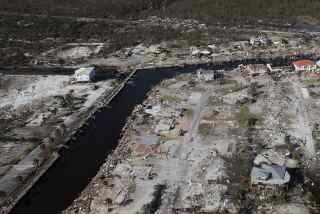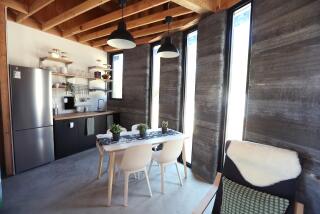Cedar Houses Are Durable as Well as Energy Efficient
Question: I have heard about cedar houses, and we want to build a natural, semi-solar type of house. What exactly is a cedar house and what are the advantages of cedar? Are they energy-efficient for all climates?
Answer: Cedar is one of the most attractive and durable types of wood for house construction. It naturally resists damage from insects, moisture and temperature extremes. Most houses are made of western red cedar, not the aromatic species used for closets, so there is no cedar smell in the house.
Cedar houses are usually sold as complete packages to be built at your site. These are beautiful homes ranging from 900-square-foot cabins to 5,000-square-foot mansions. Many are contemporary with cathedral ceilings, large windows, open floor plans--ideal for free solar heating and natural cooling.
The term “cedar house” used by manufacturers can mean many things. Some cedar houses have solid cedar walls as in a log house. Others use cedar post-and-beam construction with insulated walls. Still others use a standard framed wall with cedar siding and decorative cedar ceiling beams.
Almost all of the cedar house packages are energy-efficient. Some of the cedar post-and-beam designs have wall insulation up to R-20, roofs to R-40 and floors to R-28. This creates a comfortable house with year-round low utility bills. Selecting a solar design can increase the savings.
Although solid cedar wall construction has no conventional insulation, it is still energy-efficient. The heavy log structure has tremendous thermal mass, which creates an insulating effect. This solid wall design is particularly effective in the summer for comfort and low cooling bills.
Several manufacturers use laminated cedar logs with three- to five-ply thickness. Laminated logs are more stable than solid logs but look identical. They are also better for the environment because they can be made from smaller managed cedar farm lumber, not older forests.
One unique cedar log design, called Thermo-Lam, uses four wood plies with an extra insulating foam layer in the center. This provides R-17.5 insulation, not including the thermal mass effect from the wood itself.
All the manufacturers have hundreds of floor plan packages, but most people modify them to meet their needs. With no interior load-bearing walls, there is great interior design flexibility. Several “house that grows” packages are specifically designed to add sections as your budget and family grow.
Most cedar home packages include all exterior and interior walls, windows, doors, floor and roof materials. They are pre-drilled for plumbing and wiring.
Write for (or instant download https://www.dulley.com) Update Bulletin No. 638, a list of 15 manufactures of cedar house packages, types of construction, typical specification and eight floor-plan layouts and exterior diagrams. Please include $3 and a business-size self-addressed envelope and mail to James Dulley, Los Angeles Times, 6906 Royalgreen Drive, Cincinnati, OH 45244.
Storm Windows Can Block UV Rays
Q: I always take out our interior storm windows in the summer to clean them and leave them off. Since we use our air conditioner almost all the time, would it be better to leave them in year-round?
A: Although storm windows provide the most savings in the winter, leaving them in saves some energy in the summer too. You should take them out in spring and fall and open the windows for free natural ventilation.
The big advantage of leaving indoor storms in during the summer is the reduction in fading and sun damage to your curtains, furniture and carpet. Most indoor storm windows are made of acrylic, which blocks ultraviolet rays.
Picking an Efficient Washing Machine
Q: I am in the market for a new clothes washer and I want an energy efficient model. They all have EF ratings on the Energy Guide labels attached to them. What is EF and what level is best?
A: “EF” is an abbreviation for energy factor. For clothes washers, the EF rating basically compares how much various models can wash for each kilowatt-hour of electricity used.
The most efficient models have an EF rating above 2. Two key features that result in the highest EF ratings are adjustable water temperature and level controls. Front-loading washers are usually the most efficient.
Letters and questions may be sent to James Dulley, Los Angeles Times, 6906 Royalgreen Drive, Cincinnati, OH 45244.
More to Read
Sign up for Essential California
The most important California stories and recommendations in your inbox every morning.
You may occasionally receive promotional content from the Los Angeles Times.






